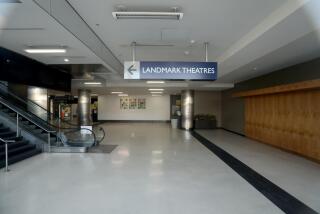JEFFERSON PARK : Busy Center Still Offering Quake Aid
- Share via
More than six months after a magnitude 6.8 earthquake rocked the city out of early morning sleep, many residents in Central Los Angeles are still waking up to the Jan. 17 Northridge temblor’s devastating effects.
Although the San Fernando Valley has received the lion’s share of media and government attention, the earthquake assistance center set up in the Crenshaw district is the busiest in the Southland.
Unlike their Valley counterparts, many quake victims in Central Los Angeles waited much longer to enlist governmental help because they didn’t know they could or were unsure if they qualified for aid, said spokeswoman Lisa Posey of the Crenshaw Earthquake Service Center at 3420 W. Jefferson Blvd. in Jefferson Park.
“I was reluctant to come in because I just figured I wouldn’t get anything,” said Maurice Prince, who came to the center to apply for money to repair damage to her Mid-City restaurant.
“I closed for one day after the earthquake, but had to keep going. . . . I just got busy. An outreach person here told me that I should come down, so I finally did.”
Of the 10 government assistance centers that opened in Los Angeles and Ventura counties after the quake, Posey said, the Crenshaw location--the only one south of the Santa Monica Freeway--has processed the most applications for aid: 6,726, compared with 4,101 at the Sylmar center. A total of 27,401 applications have been processed so far.
The Crenshaw center has seen about 40,000 clients and is still averaging about 25 applications for aid per day, Posey said. The daily number of walk-ins, including new and repeat clients, frequently tops 190 renters, home and business owners.
The complex, the former site of a Muslim school, houses not only the Federal Emergency Management Agency and the state Office of Emergency Services but several city and county agencies including the county Mental Health, Employment Development and Aging Services departments.
The bulk of clients, said Office of Emergency Services manager Floyd Godfrey, are elderly residents who were slow to discover damage or were wary of applying for government loans.
Abbie Deverges, a Crenshaw homeowner since 1950, said she was reluctant to get caught up in bureaucratic red tape although her home suffered extensive damage inside and out.
“I did get a grant for $4,000, but that didn’t cover everything,” said Deverges, a retiree who was filing an appeal at the center for additional aid. “I had to use a lot of my own money to fix things. I need to replace all my damaged windows before the rains come.”
She said she used most of the grant money to repair deep cracks and crumbled stucco in her living room, dining room and bedroom walls, and estimates it will take an another $3,000 to repair similar damage outside.
Godfrey said most of the clients are living on small incomes and cannot absorb much of a loss. The federal and state aid includes grants of up to $22,200 and loans for quake-related structural repairs for property owners and personal losses for both property owners and renters.
“The hardest thing is that though we can help people, it doesn’t really compensate them, especially homeowners,” he said. “You can go anywhere right around here, down Bronson Avenue, and find about 10 or 15 houses off their foundations. There’s only so much we can do.”
But the center, and others like it, will be helping people longer than expected: the federal government recently extended the deadline to apply for assistance to Sept. 16.
It is the third time the deadline has been extended. With the amount of foot traffic the center is still getting, and the follow-up that must be done, Godfrey said, the Crenshaw center will keep its doors open at least until Christmas. “As long as we’re needed, we’ll be here,” he said.
The center also offers preparedness and damage reduction workshops. It is open Monday through Saturday, 9 a.m. to 6 p.m.
Information: (213) 730-5764.
More to Read
Sign up for Essential California
The most important California stories and recommendations in your inbox every morning.
You may occasionally receive promotional content from the Los Angeles Times.










